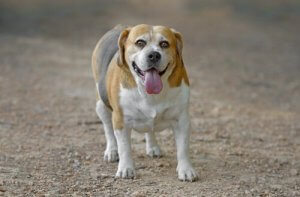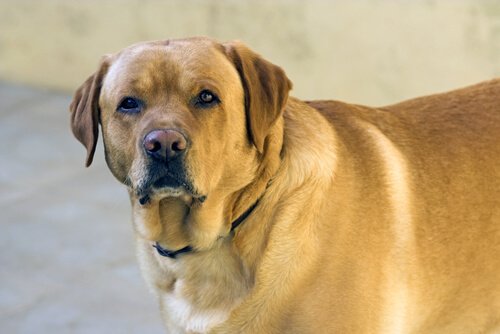My Dog is Overweight

An obese dog’s life expectancy can be significantly reduced. They run the risk of developing certain diseases. So, if you notice that your dog is overweight, you should immediately take actions for them to lose weight. A proper diet and a good dose of daily exercise will be just what your pet needs. Besides getting fit, they’ll be healthy and live longer.
How to know if your pet is overweight
To figure out if your canine friend is overweight, you can use a few simple methods. For example, the following are some signs that your dog is overweight:

- When you look at them from above, you can’t see their waist.
- When you press on their ribs with your fingers, you can’t feel them, at least not so easily.
- You see a buildup of fat at the base of their tail.
If your dog is overweight, get professional help and follow a customized wieghtloss plan that includes diet and exercise.
Follow a weightloss plan according to your dog’s traits
Each dog is unique. Their diet and level of activity should be adapted to their age, size, and other traits.
The nutritional needs of a puppy aren’t the same as those of an adult dog, much less a senior dog. But neither are the requirements of a small dog breed are the same as those of a large dog.
Also, not all canines are the same when it comes to physical activity. So, you should consult with a vet about the best way to feed and exercise with your canine friend during each stage of their life.
Also, if you have a sedentary lifestyle, and you also like to snack between meals, pay close attention to your pet, because you might be encouraging them to have a similar routine. Thus, they’ll gain weight too.
How to feed your overweight dog
At mealtimes, you should take the following tips into consideration to help your dog get back to their ideal weight:
- Give them food that suits their age, breed, and size. There is a wide variety of food for all of your dog’s needs in pet stores. A veterinarian will also be able to advise you about which food is the most suitable for your furry friend.
- If you opt for homemade food, ask an animal nutritionist to come up with a diet that fits your pet’s needs.
- Calculate their daily food portions as well. You should not overdo it, neither should your dog go hungry.
- When giving treats, choose ones that they would like and that are healthy too. Also, don’t forget to include these treats in your dog’s daily calorie intake.
Exercise, the healthiest option for weight control
Exercise and playing with your pet on a daily basis are essential not only for the dog to stay in shape, but also so they could have good psychophysical health.
Depending on your dog’s age and traits, a few good daily walks and some playtime at home or in a park might be enough. In any case, don’t force your dog to do more exercise than they can handle. Go step by step and stop when you notice that they’re exhausted.
Special activities for animals with excessive energy

Some animals have high energy levels and need even more activity. Even though these dogs are simply adorable pets in today’s age, they were once used to:
- Pull sleds
- Herd livestock
- Track carriages
- Hunt
- Track
If you have a dog with this peculiarity and you don’t want to, or can’t exercise to their pace, then ask for help from family members and friends. Likewise, if you’re financially capable of doing so, take them to a school to be trained in canine sporting competitions.
Therefore, don’t waste any more time if you see that your dog is overweight. Take care of them, and likewise take care of yourself.
An obese dog’s life expectancy can be significantly reduced. They run the risk of developing certain diseases. So, if you notice that your dog is overweight, you should immediately take actions for them to lose weight. A proper diet and a good dose of daily exercise will be just what your pet needs. Besides getting fit, they’ll be healthy and live longer.
How to know if your pet is overweight
To figure out if your canine friend is overweight, you can use a few simple methods. For example, the following are some signs that your dog is overweight:

- When you look at them from above, you can’t see their waist.
- When you press on their ribs with your fingers, you can’t feel them, at least not so easily.
- You see a buildup of fat at the base of their tail.
If your dog is overweight, get professional help and follow a customized wieghtloss plan that includes diet and exercise.
Follow a weightloss plan according to your dog’s traits
Each dog is unique. Their diet and level of activity should be adapted to their age, size, and other traits.
The nutritional needs of a puppy aren’t the same as those of an adult dog, much less a senior dog. But neither are the requirements of a small dog breed are the same as those of a large dog.
Also, not all canines are the same when it comes to physical activity. So, you should consult with a vet about the best way to feed and exercise with your canine friend during each stage of their life.
Also, if you have a sedentary lifestyle, and you also like to snack between meals, pay close attention to your pet, because you might be encouraging them to have a similar routine. Thus, they’ll gain weight too.
How to feed your overweight dog
At mealtimes, you should take the following tips into consideration to help your dog get back to their ideal weight:
- Give them food that suits their age, breed, and size. There is a wide variety of food for all of your dog’s needs in pet stores. A veterinarian will also be able to advise you about which food is the most suitable for your furry friend.
- If you opt for homemade food, ask an animal nutritionist to come up with a diet that fits your pet’s needs.
- Calculate their daily food portions as well. You should not overdo it, neither should your dog go hungry.
- When giving treats, choose ones that they would like and that are healthy too. Also, don’t forget to include these treats in your dog’s daily calorie intake.
Exercise, the healthiest option for weight control
Exercise and playing with your pet on a daily basis are essential not only for the dog to stay in shape, but also so they could have good psychophysical health.
Depending on your dog’s age and traits, a few good daily walks and some playtime at home or in a park might be enough. In any case, don’t force your dog to do more exercise than they can handle. Go step by step and stop when you notice that they’re exhausted.
Special activities for animals with excessive energy

Some animals have high energy levels and need even more activity. Even though these dogs are simply adorable pets in today’s age, they were once used to:
- Pull sleds
- Herd livestock
- Track carriages
- Hunt
- Track
If you have a dog with this peculiarity and you don’t want to, or can’t exercise to their pace, then ask for help from family members and friends. Likewise, if you’re financially capable of doing so, take them to a school to be trained in canine sporting competitions.
Therefore, don’t waste any more time if you see that your dog is overweight. Take care of them, and likewise take care of yourself.
All cited sources were thoroughly reviewed by our team to ensure their quality, reliability, currency, and validity. The bibliography of this article was considered reliable and of academic or scientific accuracy.
White, G. A., Hobson-West, P., Cobb, K., Craigon, J., Hammond, R., & Millar, K. M. (2011). Canine obesity: Is there a difference between veterinarian and owner perception? Journal of Small Animal Practice. https://doi.org/10.1111/j.1748-5827.2011.01138.x
Yam, P. S., Butowski, C. F., Chitty, J. L., Naughton, G., Wiseman-Orr, M. L., Parkin, T., & Reid, J. (2016). Impact of canine overweight and obesity on health-related quality of life. Preventive Veterinary Medicine. https://doi.org/10.1016/j.prevetmed.2016.03.013
Heuberger, R., & Wakshlag, J. (2011). The relationship of feeding patterns and obesity in dogs. Journal of Animal Physiology and Animal Nutrition. https://doi.org/10.1111/j.1439-0396.2010.01024.x
This text is provided for informational purposes only and does not replace consultation with a professional. If in doubt, consult your specialist.








